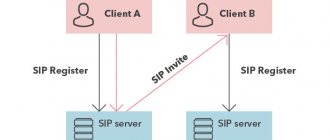IP telephony is telephone communication over the Internet, and not through conventional telephone networks. This type of telephony became possible as soon as the web of the Internet became comparable and even larger than the web of telephone lines that entangled the Earth long before the Internet.
The difference between IP telephony and analog telephony is the absence of a traditional cable and telephone set. True, there are options for IP telephony that are outwardly indistinguishable from conventional telephone communication, with familiar devices and wires. Communication is carried out through devices with direct access to the Internet. This can be not only computers, but also tablets or mobile devices. An audio headset is also required if the computer does not have speakers and a microphone.
The main advantage is the minimum cost of operation, the cost of paying for calls, in comparison with analogue telephony or cellular communications.
This telephony is especially popular in offices, opening up opportunities for significant savings. After all, office workers do nothing but call the company’s clients, contractors, and for other reasons.
It is important that communication costs are reduced regardless of which region of the country or other state the connection is made with, because for the Internet, unlike regular telephone communications, there are no state or national borders. Simplicity of configuration and a sufficient level of security makes it possible for IP telephony to compete adequately with analog telephony, gradually displacing it for corporate needs.
At the household level, IP telephony was once quite widespread in the form of cards for long-distance and international communications.
Cardtel card for calling from a landline phone via IP telephony
Having purchased such a card for relatively little money, access to the servers of the company providing access to IP telephony was opened from a regular home phone. The numbers for dialing to the servers were published on the card, and then, according to the usual rules for dialing a long-distance or international number, it was possible to call another subscriber, but via the Internet, and not via a telephone line. And the telephone line was used in this case at the cheapest rate: in the section between the phones of speaking subscribers and servers located in the same cities and countries to provide IP telephony.
Basic principles of how IP telephony works
When making a call, the voice signal coming from the subscriber is compressed and converted into a data packet sent via IP networks. Once at the recipient's address, the transmitted information is decoded back, acquiring the format of a familiar voice signal. All this happens in a matter of seconds, thanks to which information is transmitted in real time without loss of broadcast quality.
This positive result is facilitated by protocols that act as a kind of encrypted language that unites subscribers and allows them to transfer data to each other. IP telephony is implemented on the basis of several of the most popular types of protocols.
Operating principle
VOIP technology allows you to convert the voice signal into digital data, which is then sent over the Internet in digital form and again transformed into an analog signal. Thanks to this process, the IP telephony subscriber hears the voice of the interlocutor, as in a normal telephone conversation. VOIP telephony is currently becoming more widespread, since high-speed Internet has long become an integral part of the life of any participant in business relationships. Of course, IP telephony developed earlier in Moscow and other megacities, since high-speed Internet in the epicenters of business activity became the norm at the corporate and household level much faster. The required channel width for one IP telephony line is only 100 Kbps.
“We started using Telfin on the recommendation of our partners. I was attracted by the optimal price-quality ratio of the service, as well as its functionality. Thanks to virtual communications, we have improved the work of service and technical support. This increased the speed of processing applications and, most importantly, we stopped losing customer calls.”
— Alexander Zarutsky, technical director
Connecting and setting up IP telephony
To use the technology, you need access to the Internet and the appropriate equipment: routers, routers, servers, etc.
A software connection to IP telephony consists of installing on a computer, laptop or gadget an appropriate application that supports communication using a protocol that ensures the operation of IP telephony.
The software is mostly free. To use it, you need an account in the application, into which the data required for operation is entered. A set of basic functions is installed by default; it is possible to expand them and make adjustments to the settings.
Physical level.
At this level, a stream of bits is transmitted over the physical medium. IP telephony can use all the capabilities of existing networks for this purpose. This includes twisted pair, optical fiber, and coaxial cable.
PoE technology is actively used at the physical level
— technology for providing subscriber devices with power over standard twisted pair cables.
In this sense, IP telephony inherits the useful property of classical telephony - providing power to devices via subscriber lines. That is. do without special power supplies for each device. And this significantly reduces the cost and simplifies the operation of the communication system.
.
The history of IP telephony
For a long time, the transmission of voice information was carried out in the traditional way using only telephone networks, but in the late 80s the idea arose to use the World Wide Web for this.
It became possible to transmit audio and video files, text messages over the Internet via ISDN. But this program did not find a response, since it worked very slowly and until 1995, innovative developments were not carried out in this direction.
Then the first example of Internet telephony from Israel appeared. But it worked one-way, on the principle of walkie-talkies, requiring identical software from the users between whom communication was carried out. It was also quite common at that time for data to be lost during transmission, mainly due to the low speed of the Internet at that time.
SECURITY OF VOIP CALLS
Digital telephony is susceptible to unauthorized access to transmitted voice data. The best option is to use cryptographic protection, which is common in corporate networks, but not used in public networks. If subscribers use a secure gateway for their network, this will avoid many hassles with unauthorized access to telephone calls.
The use of cryptographic algorithms SRTP, ZRTP in modern models of VOIP phones can serve as a good alternative to secure gateways.
A reasonable alternative is to secure it with a Voice VPN (which combines a VPN and a VOIP network using IPSec algorithms).
Towards modern achievements of IP telephony
Until 1996, IP telephony developed on the principle of transferring information from computer to computer using communicator programs. But in 1997, the integration of telephone networks with the so-called “packet” networks, in fact with the Internet networks, took place, which became possible thanks to the adoption of the standard H323 data transfer protocol.
Based on this protocol, the first phones began to work, equipped with a special connector for connecting to a data network and requiring not only a telephone socket, but also a separate port. When the switch was overloaded, it took time to rebuild it, which led to a long-term loss of interest in this area.
Changes occurred in 2002, when, with the development of the popularity of the new SIP protocol, which appeared back in 1999, packet telephony began to be actively implemented. After another 3 years, with the help of a new VoIP router, it became possible to operate telephony without turning on the computer at all.
Since then, the popularity of IP telephony has been constantly growing. For ordinary users, it is not of fundamental importance what protocols are used and how they work. Clean communication, additional features and low tariffs are much more important to them.
Data layer.
This is the highest level of data transfer. In fact, it combines three levels. but to understand that. how IP telephony works on the “upper floors”, this division is not fundamental.
An important feature of this layer is the stack (set) of H.323 . Essentially, it is a set of standards and recommendations for hardware, network services, and terminal devices.
H.323 standards require that all IP telephony equipment and network services
- do not depend on a specific platform, i.e. work on any basis.
- support the same analog data encoding standards
- have common bandwidth management standards, i.e. “have the same understanding” of how to manage channel capacity.
- combine flexibility and compatibility.
That's very important. that the H.323 recommendations do NOT define the following characteristics:
- physical transmission medium
- transport protocol
- network interface.
Thus, if you want to comply with H.323 standards, be kind enough to work on any platform and with any transport protocol.
Advantages of IP telephony
The main one is the ability to save communication costs, which is especially important when using long-distance and international calls. Also worth noting as advantages:
- Availability and mobility,
since numbers in IP telephony are not tied to a specific location, to a specific cable, to a specific connector.
This essentially virtual number can be accessed regardless of the geography of its location; all you need is high-speed Internet access. It turns out to be a kind of analogue of mobile communications, only instead of access to mobile networks, access to the Internet is required.
- High potential
since the formation of new IP networks is carried out depending on the needs of users and it is possible to quickly expand configurations with the introduction of new services.
- Privacy and security.
Thanks to encrypted communication channels, access to information to third parties is prohibited, unlike the old familiar telephone networks, to which anyone can connect anywhere where the cable runs.
- Wide possibilities,
not limited to voice data transmission. Using IP telephony, you can organize audio conferences, send information in text and other formats.
The use of IP telephony is the optimal solution for offices, enterprises and organizations precisely because of the last point about capabilities.
- Multichannel number functions,
- forwarding of incoming calls,
- voice mail,
- virtual fax and
allow you to get the most out of your connection without making any effort.
Most IP telephony services are included in the basic package and are used after paying for the provider's services for such communication. It is possible to increase the number of rooms beyond the initial tariff plan, but in this case additional costs will be incurred.
TECHNOLOGY FOR DETERMINING CALL QUALITY
Digital telephony operators provide various mechanisms for analyzing and counting the traffic used. The use of additional statistical parameters allows you to automatically select the highest quality (or inexpensive) connection in the desired direction:
- ASR/ABR - means the percentage of the number of calls made to the number of all attempts to call;
- ACD is the average duration of a conversation through a specific node in a selected direction, expressed as a percentage. Allows you to determine the most stable direction of communication.
- PDD - delay time from dialing to starting a conversation;
- CPS is the number of calls made per second.
Detailed information about calls by the dispatcher (PBX) is recorded in a special CDR record. Each entry contains:
- calling subscriber number (A-number);
- number of the called subscriber (B-number);
- IP address of each subscriber;
- time and duration of the call (or refusal to establish a connection);
- reason for ending the call (voluntary or forced for technical reasons).
CDR records are uploaded to the billing system for analysis and reporting.
About the cost of IP telephony
When using VOIP telephony, you can clearly see the dramatic difference in prices compared to analog communications. Within the network, calls are not charged, that is, subscribers using the services of one IP telephony provider communicate via software or hardware VOIP phones, saving money.
Since traffic on the Internet is not geographically referenced, the distance between the region of sending and the region of receiving information also does not play a role, unlike the usual telephone communication, which works on the principle “the further, the more expensive.” There is no additional charge for sending traffic in any direction.
When calling mobile or landline phones abroad or to other regions, the cost is also an order of magnitude lower than on an analog network. There are no subscriber line fees, but it’s true that instead you need to pay for Internet use at the rates of your Internet provider.
The cost of calls to mobile and landline phones depends on the chosen direction and starts from several tens of kopecks per minute. The specific figure is related to the cost of services of a provider that supports IP telephony. The company involved in setting up and connecting such communications will help you choose the optimal package based on the customer’s needs. A combination of services from several providers is possible, which is guaranteed to lead to a reduction in bills for communication services.
IP telephony competitor: Skype
Applications for maintaining telephone and video communications, for example, the well-known Skype, quite successfully compete with IP telephony. Similar applications for computers and mobile devices allow voice and video communication between subscribers also via the Internet, and also have attractive tariffs.
By the way, many functions of such applications are generally free. Users only need to pay for Internet traffic, nothing more. For example, Skype calls between two subscribers who have the Skype application installed on their computers are free.
And even group audio and video conferences on Skype between several Skype subscribers can be free. It is also possible to transmit visual information by “sharing” (organizing collective viewing) one of the computer screens connected to the Skype conference.
IP telephony competitors: mobile operators
In addition, mobile operators do not stand still. They offer their corporate clients so-called virtual telephony. Its essence is that each employee of a corporation (firm) is assigned a short number (3-4 digits), as if it were the employee’s internal telephone number. And all employees of one company can call each other using these short numbers, but using mobile phones or special telephones connected directly to the company’s servers that provide Internet access.
The peculiarity of mobile virtual telephony is that it does not link the employee to the workplace, to a specific city, or even to a specific country. A short number assigned to a company employee “travels” with him everywhere, along with his gadget and SIM card. The result is an analogue of IP telephony that is comparable in price and does not require anything at all from users (and companies) except mobile phones (smartphones, iPhones) and SIM cards of the mobile operator.
Server from 3CX
The 3CX Phone System SIP server is designed for telephony for businesses of any size. These can be small firms or large corporations with dozens of branches, divisions and divisions. It supports the full functionality of office PBXs - work with calls, integration into CRM, conference calls, call center functions and much more. The product is notable for its comprehensive support from the developer. Working environment – Windows operating system. It will not be possible to implement your own developments, as in Asterisk, due to the closed source code of the server.
Unified Communications UC (Unified Communication)
The UC (Unified Communication) unified communications service is a further development of the capabilities of corporate IP telephony.
UC is gaining popularity and now more and more enterprises are choosing the UC platform to consolidate all corporate communication channels and reduce IT and communication costs. If all communication channels (telephone, email and voice mail, chat, instant messengers, video conferencing, file sharing, etc.) are combined on one platform, this not only reduces management overhead, but also makes the business more efficient overall. Therefore, they often talk not about UC, but about UCC (Unified Communication and Collaboration, unified communications and teamwork).
UC concept
According to the Mordor Intelligence analytical agency for 2019, the UC cloud services market will reach $17,165.9 million in 2024 with a CAGR of 25.67%.
UCC can improve the efficiency of enterprises of almost any size and type of business, for example, through remote work of employees and constant indication of the presence of other employees on the network who are ready to exchange information.
Moreover, the range of UC services is rapidly expanding and new services are appearing that previously seemed either technically impossible or unnecessary.
Key Benefits of Switching to a UC Platform for Enterprises
Example UC Platform User Interface
- Maintaining high staff motivation
The 2021 National Employee survey found that 52% of workers in the UK, both in the public sector and in business, are planning to change jobs. The main reason is the low technical equipment of workplaces, lack of effective communication services and the impossibility of remote work. One of the main attractive features of UC is that the platform can support a wide range of employee presence functionality, the ability to have access to corporate data even outside the enterprise network, and the ability to use instant messengers and teleconferencing for work. Thus, UC is a good way to retain qualified personnel and increase their loyalty to the company.
- Quick response to requests from colleagues and customers
In today's world, work teams work globally, in different countries and regions, and regular telephone communications, even VoIP, no longer fully meet the needs of distributed work teams. UC systems, on the contrary, even allow you to get rid of the problem, since when calling through UC you can quickly find the right employee, and for an external customer, you can quickly find the person responsible for resolving his particular issue. Registration of calls in the database and the use of machine learning allows you to identify VIP customers by voice.
- Cost reduction
Since using UC, more and more staff can work remotely, office rental and maintenance costs are reduced. UC also helps reduce mobile costs as telecom expenses can be paid centrally in a single package.
- Revenue growth
Improving the level of customer service using rich UC functions helps to increase sales volumes of enterprise products and services. UC helps to track all missed calls and requests from potential customers, quickly respond to their complaints, thus increasing the reputation of the enterprise and the percentage of successful proposals.
OfficeSIP Server
Free application for organizing office telephone communication. Suitable for small and medium-sized offices that do not require additional functions. For large enterprises with divisions and branches around the world, this SIP server is not suitable. But connecting the accounting department, directors, human resources department, several offices with access to intercity and international communications is always welcome.
The server runs under the Windows operating system and does not create any difficulties. It is free even for business clients, which determines some demand for this product. Installation is quick and without delays; registration of new subscribers is done in a couple of mouse clicks. If you are faced with the task of setting up a connection yourself, but you do not have much experience, use this simple and free solution.











